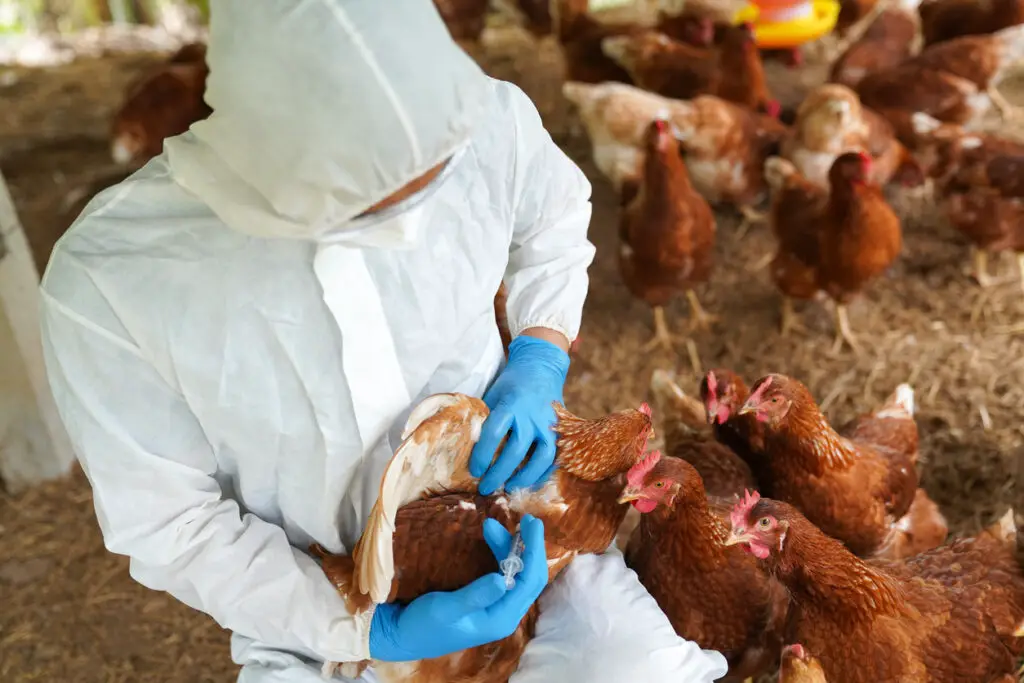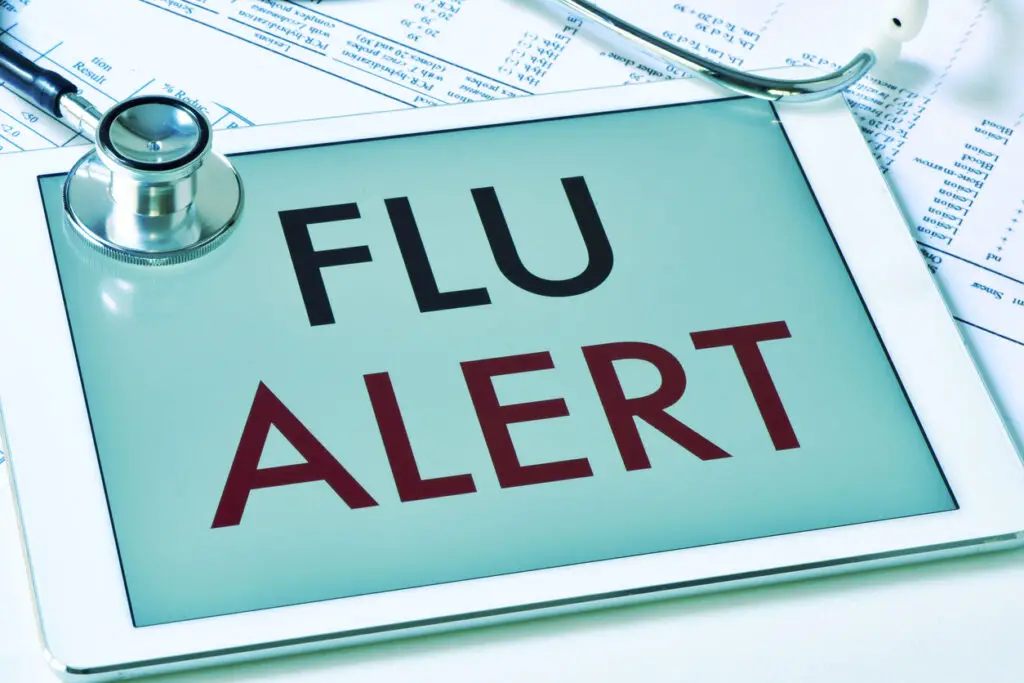1. Myth: Bird Flu Only Affects Birds

Fact: Other Animals (and Even Humans) Can Get It Too
It’s easy to assume that bird flu is strictly a bird problem—after all, the name suggests it. But the truth is, this virus isn’t picky. While it primarily infects birds, cases have been reported in a surprising range of mammals, including cows, dogs, cats, and even humans. Scientists have been particularly alarmed by its ability to jump between species, as every new infection is an opportunity for the virus to mutate into something even more dangerous. The more it spreads, the higher the chance it could eventually adapt to human-to-human transmission.
That doesn’t mean we’re on the verge of a pandemic just yet, but it does mean bird flu is more than just a backyard chicken issue. People who work closely with birds, like farmers and veterinarians, have a higher risk of exposure. While human infections are still rare, a few cases have been recorded globally, and scientists are keeping a close watch on any changes in the virus. This isn’t about unnecessary panic—it’s about awareness. The more we understand how bird flu operates, the better prepared we are to prevent it from turning into a much bigger problem.
2. Myth: You Can Catch Bird Flu Just by Eating Chicken or Eggs

Fact: Properly Cooked Poultry and Eggs Are Safe to Eat
There’s a lot of fear around eating chicken and eggs during a bird flu outbreak, but let’s clear this up right away: you won’t get bird flu from eating properly cooked poultry or eggs. The virus doesn’t survive high cooking temperatures, meaning that as long as you’re thoroughly cooking your food—chicken to at least 165°F (74°C) and eggs until the yolks are firm—you have nothing to worry about. No amount of panic should stop you from enjoying your favorite chicken dishes or a hearty omelet in the morning.
However, where you should be cautious is in handling raw poultry. If an infected bird was recently slaughtered, the virus could still be present in raw meat, surfaces, or even feathers. That’s why it’s crucial to follow basic food safety practices: wash your hands, clean surfaces thoroughly, and avoid cross-contamination between raw meat and ready-to-eat foods. So, while you don’t need to clear your fridge of poultry, a little extra caution in the kitchen can go a long way in staying safe.
3. Myth: Bird Flu Spreads Like the Common Cold

Fact: Bird Flu Spreads Differently, and Human-to-Human Transmission Is Rare
When people hear about a virus outbreak, they often assume it spreads the same way as the flu or a cold—through coughs, sneezes, or touching contaminated surfaces. But bird flu is different. It primarily spreads through direct contact with infected birds, their droppings, or contaminated environments, rather than through casual human interaction. That’s why most recorded human infections have happened in people who work closely with poultry, like farmworkers or those involved in culling infected birds.
The big concern, though, is what if bird flu mutates to spread easily between humans? Right now, that’s not happening, but scientists are watching closely. If the virus gains the ability to spread like the seasonal flu—through respiratory droplets or even casual contact—that’s when we could have a serious problem on our hands. Until then, the best defense is limiting exposure to sick birds and practicing good hygiene if you handle poultry. For now, you’re far more likely to catch the common cold from your coworker than bird flu from your neighborhood chickens.
4. Myth: Backyard Chickens Are the Biggest Threat to Spreading Bird Flu

Fact: Large-Scale Poultry Farms Are More at Risk
Many people assume that backyard chicken owners are walking disease factories, putting entire communities at risk of bird flu. While it’s true that any bird can carry the virus, small-scale flocks actually have a lower risk compared to massive commercial poultry farms. Why? Because factory farms pack thousands of birds into tight spaces, creating the perfect environment for a virus to spread like wildfire. One infected bird can quickly turn into an outbreak, forcing farms to cull entire flocks to prevent further spread.
Backyard chickens, on the other hand, usually have more space, better air circulation, and less exposure to outside birds if properly managed. That said, small flock owners still need to take precautions, like keeping their birds away from wild fowl, maintaining clean coops, and watching for any signs of illness. The real risk isn’t your neighbor’s three hens—it’s the industrial-scale farms where a single outbreak can cause economic and supply chain disasters. Understanding this distinction helps keep the focus on practical solutions rather than unnecessary fear.
5. Myth: Only Rural Areas Need to Worry About Bird Flu

Fact: Bird Flu Can Show Up in Cities Too
It’s tempting to think of bird flu as something that only affects rural farmers and remote villages, but that’s not the case. With wild birds acting as carriers, the virus can show up anywhere—even in major cities. Urban parks, waterfronts, and even backyard bird feeders can attract migrating birds that might be carrying the virus. This means that even if you live far from a farm, bird flu isn’t necessarily far from you.
That doesn’t mean city dwellers need to panic, but it does mean we should all be mindful of our interactions with birds. If you love feeding ducks or pigeons, be aware that direct contact with bird droppings or contaminated water can carry risks. Pet owners should also be cautious—outdoor cats and off-leash dogs that chase or eat birds could be exposed. While urban outbreaks are less common, they’re not impossible, and being aware of the risks helps everyone play a role in preventing the virus from spreading.
6. Myth: If Bird Flu Becomes a Human Pandemic, We’re Doomed

Fact: Scientists Are Preparing, and There Are Ways to Protect Ourselves
Let’s be real—any mention of a potential pandemic immediately brings up bad memories of lockdowns, masks, and global panic. But just because bird flu could mutate into a human-to-human virus doesn’t mean we’re helpless. Scientists have been monitoring this virus for decades and are already working on vaccines and treatments in case it ever makes the jump. While it’s always good to be cautious, assuming that we’re all doomed isn’t productive or accurate.
Governments and health organizations are also paying close attention. Surveillance programs track outbreaks in birds and mammals, giving us an early warning system for potential changes in the virus. If the worst happens, we have tools like antiviral medications, vaccines, and public health measures to slow the spread. The key takeaway? Stay informed, but don’t give in to fear. Preparation is different from panic, and when we focus on facts instead of worst-case scenarios, we’re much better equipped to handle whatever comes next.
7. Myth: A Mask or Gloves Can Fully Protect You from Bird Flu

Fact: Protection Depends on Your Level of Exposure and Hygiene Practices
It’s natural to think that wearing a mask and gloves will keep you completely safe from bird flu, but it’s not that simple. While protective gear can help reduce the risk of exposure—especially for people working closely with birds—it’s not a foolproof solution. The virus is primarily spread through direct contact with infected birds, their droppings, or contaminated surfaces, which means proper hygiene and sanitation matter just as much as wearing a mask. A person who wears gloves but then touches their face or eats without washing their hands could still be at risk.
For everyday people who aren’t handling birds regularly, masks and gloves aren’t necessary. The real key to protection is avoiding direct contact with sick birds, washing hands thoroughly after handling animals, and ensuring pets don’t come into contact with infected wildlife. If you work on a farm or in a high-risk setting, additional protective measures make sense—but for the average person, smart hygiene is your best defense. Instead of relying solely on gloves or masks, think about your overall habits and exposure risks.
8. Myth: All Birds Die If They Catch Bird Flu

Fact: Some Birds Can Survive and Even Spread the Virus Without Symptoms
It’s easy to assume that bird flu is always fatal to birds, but that’s not entirely true. While many domesticated birds, like chickens and turkeys, often die quickly from severe strains of the virus, some wild birds—especially waterfowl like ducks and geese—can carry and spread bird flu without showing any symptoms at all. This is part of what makes the virus so difficult to contain. Migratory birds can fly across continents, silently spreading the disease to new regions without ever appearing sick.
Even in poultry farms, not every infected bird dies immediately. Some may carry the virus for a short time before showing symptoms, allowing it to spread to others in the flock. This is why routine testing and biosecurity measures are critical in poultry farming. The idea that bird flu wipes out every bird it touches isn’t true—but the fact that some birds can act as silent carriers makes the virus even more challenging to control. That’s why surveillance efforts and quick response strategies are so important.
9. Myth: Once an Outbreak is Over, Bird Flu is Gone for Good

Fact: Bird Flu Can Linger and Resurface in Unexpected Ways
A common misconception is that once an outbreak is over, bird flu disappears completely—but that’s not how viruses work. Even after an outbreak dies down, the virus can linger in wild bird populations, infected environments, or even frozen meat from infected poultry. This means bird flu can make a sudden comeback, even in places that haven’t seen cases for months or years. Scientists are constantly monitoring bird flu hotspots because they know the virus never truly “goes away”—it just finds new ways to spread.
This is why poultry farmers and wildlife experts don’t let their guard down after an outbreak. The virus can remain in bird droppings, contaminated soil, or water sources, creating opportunities for reinfection. It can even spread through the illegal trade of wild birds or infected poultry products. So, while we may not hear about bird flu every day, that doesn’t mean it’s gone—it just means we’re in a temporary lull before the next outbreak. The key is ongoing vigilance, not complacency.
10. Myth: Pets Can’t Get Bird Flu

Fact: Dogs, Cats, and Even Cows Have Tested Positive for the Virus
Many people assume that bird flu is strictly a bird disease and that their pets are completely safe. Unfortunately, that’s not true. While rare, cases of bird flu have been reported in cats, dogs, and even cows. Infected pets are usually exposed after eating raw or sick birds, which means outdoor pets that hunt or scavenge are at higher risk. This is why experts recommend keeping pets away from wild birds and ensuring they’re not eating raw poultry from questionable sources.
While there’s no evidence yet that infected pets can easily pass the virus to humans, the fact that the virus is jumping into new species is concerning. Scientists are keeping a close eye on these developments because every new host increases the chance of the virus mutating into something more dangerous. For now, the best way to protect your pets is to monitor their outdoor activities, avoid feeding them raw meat, and keep them away from dead or sick birds. If you notice unusual symptoms in your pet, like respiratory distress or loss of appetite, it’s worth checking with a vet.
11. Myth: The Flu Vaccine Will Protect You from Bird Flu

Fact: Seasonal Flu Shots Don’t Cover Bird Flu Strains
Getting your annual flu shot is a great way to protect yourself from seasonal flu, but it won’t do much against bird flu. The strains of influenza that circulate in humans are different from those found in birds, and the flu vaccine is specifically designed to target the most common human strains. That means if bird flu were to mutate and start spreading between humans, we’d likely need an entirely new vaccine to combat it.
That said, getting a flu shot is still a good idea. It won’t protect you from bird flu itself, but it can help reduce the risk of co-infection, which is when someone gets both seasonal flu and bird flu at the same time. Co-infections can create opportunities for viruses to exchange genetic material, potentially leading to new, more dangerous strains. So, while your flu shot won’t stop bird flu directly, it still plays a role in keeping flu viruses under control and preventing new threats from emerging.
12. Myth: Bird Flu is a Hoax or Overblown Media Hype

Fact: The Threat is Real, but Fear-Mongering Doesn’t Help
With so much misinformation floating around, it’s understandable that some people believe bird flu is just another case of media exaggeration. But bird flu isn’t a hoax—it’s a real virus that has caused serious outbreaks in birds and has, on rare occasions, infected humans. The fact that scientists and governments are monitoring it so closely isn’t about creating panic; it’s about staying ahead of a virus that has the potential to become a much bigger problem if left unchecked.
That said, fear-mongering and misinformation can be just as dangerous as the virus itself. Panicked responses, like mass culling of animals without scientific backing or avoiding poultry entirely, don’t help the situation. The best approach is a balanced one: staying informed, following expert guidance, and taking reasonable precautions without giving in to unnecessary fear. Bird flu is a real concern, but knowledge and preparedness—not panic—are the best tools for dealing with it.


